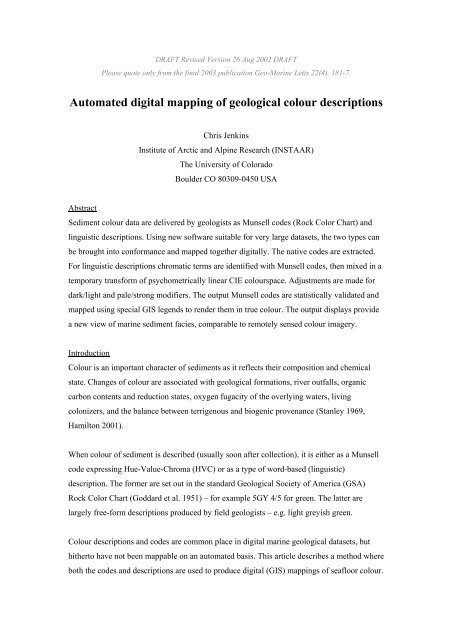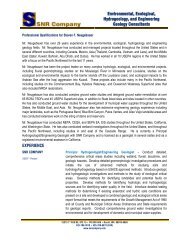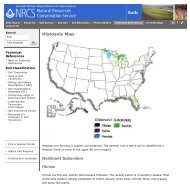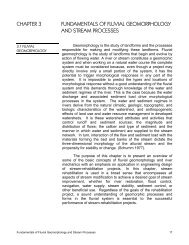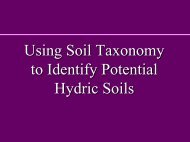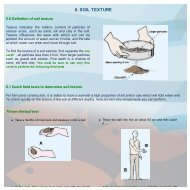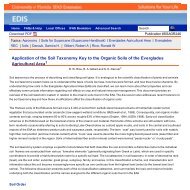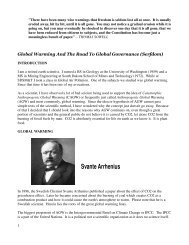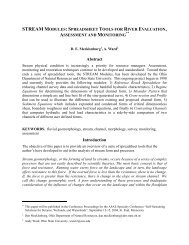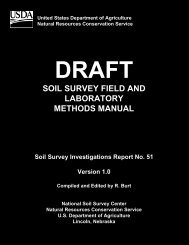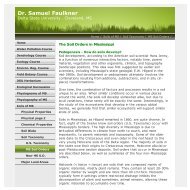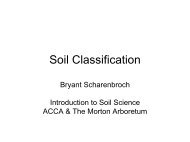Munsell Colors in GSA Document.pdf
Munsell Colors in GSA Document.pdf
Munsell Colors in GSA Document.pdf
You also want an ePaper? Increase the reach of your titles
YUMPU automatically turns print PDFs into web optimized ePapers that Google loves.
DRAFT Revised Version 26 Aug 2002 DRAFT<br />
Please quote only from the f<strong>in</strong>al 2003 publication Geo-Mar<strong>in</strong>e Letts 22(4), 181-7.<br />
Automated digital mapp<strong>in</strong>g of geological colour descriptions<br />
Chris Jenk<strong>in</strong>s<br />
Institute of Arctic and Alp<strong>in</strong>e Research (INSTAAR)<br />
The University of Colorado<br />
Boulder CO 80309-0450 USA<br />
Abstract<br />
Sediment colour data are delivered by geologists as <strong>Munsell</strong> codes (Rock Color Chart) and<br />
l<strong>in</strong>guistic descriptions. Us<strong>in</strong>g new software suitable for very large datasets, the two types can<br />
be brought <strong>in</strong>to conformance and mapped together digitally. The native codes are extracted.<br />
For l<strong>in</strong>guistic descriptions chromatic terms are identified with <strong>Munsell</strong> codes, then mixed <strong>in</strong> a<br />
temporary transform of psychometrically l<strong>in</strong>ear CIE colourspace. Adjustments are made for<br />
dark/light and pale/strong modifiers. The output <strong>Munsell</strong> codes are statistically validated and<br />
mapped us<strong>in</strong>g special GIS legends to render them <strong>in</strong> true colour. The output displays provide<br />
a new view of mar<strong>in</strong>e sediment facies, comparable to remotely sensed colour imagery.<br />
Introduction<br />
Colour is an important character of sediments as it reflects their composition and chemical<br />
state. Changes of colour are associated with geological formations, river outfalls, organic<br />
carbon contents and reduction states, oxygen fugacity of the overly<strong>in</strong>g waters, liv<strong>in</strong>g<br />
colonizers, and the balance between terrigenous and biogenic provenance (Stanley 1969,<br />
Hamilton 2001).<br />
When colour of sediment is described (usually soon after collection), it is either as a <strong>Munsell</strong><br />
code express<strong>in</strong>g Hue-Value-Chroma (HVC) or as a type of word-based (l<strong>in</strong>guistic)<br />
description. The former are set out <strong>in</strong> the standard Geological Society of America (<strong>GSA</strong>)<br />
Rock Color Chart (Goddard et al. 1951) – for example 5GY 4/5 for green. The latter are<br />
largely free-form descriptions produced by field geologists – e.g. light greyish green.<br />
Colour descriptions and codes are common place <strong>in</strong> digital mar<strong>in</strong>e geological datasets, but<br />
hitherto have not been mappable on an automated basis. This article describes a method where<br />
both the codes and descriptions are used to produce digital (GIS) mapp<strong>in</strong>gs of seafloor colour.
The work is part of the dbSEABED programme for the process<strong>in</strong>g of large mar<strong>in</strong>e geological<br />
datasets (Jenk<strong>in</strong>s 1997). This style of <strong>in</strong>formation process<strong>in</strong>g aims to m<strong>in</strong>e diverse forms of<br />
data and produce a conformable <strong>in</strong>formation-rich product which is useful <strong>in</strong> digital mapp<strong>in</strong>g,<br />
statistics, <strong>in</strong>put for models and for queries.<br />
Procedure<br />
<strong>Munsell</strong> codes<br />
AH <strong>Munsell</strong> (1923) formalized a colour space which conveys the common perception of<br />
colours through Hue, Value and Chroma. Hue is the spectral content (red, yellow, green, blue,<br />
purple), Value refers to lightness, and Chroma is the vividness or saturation. Schemes us<strong>in</strong>g<br />
HVC tend to conform to cultural colour vocabularies (see Roget 1852). A later Renotation<br />
<strong>Munsell</strong> colourspace (Newhall et al. 1943) corrected some of the distortions of <strong>Munsell</strong>'s<br />
system. This modern <strong>Munsell</strong> system is very widely used for <strong>in</strong>dustrial production and was<br />
formalized <strong>in</strong> geological sciences by the <strong>GSA</strong> Rock Color Chart which displays <strong>Munsell</strong><br />
codes with their verbal descriptive equivalents and sample colour tablets. The 3 dimensional<br />
<strong>Munsell</strong> colourspace is visualized as a cyl<strong>in</strong>der, with Hues arranged around the radius (colour<br />
wheel), Chroma radiat<strong>in</strong>g away from the axis, and Values <strong>in</strong>creas<strong>in</strong>g axially from base to top.<br />
S<strong>in</strong>ce the publication of the Rock Color Chart it has been commonplace to <strong>in</strong>clude <strong>Munsell</strong><br />
codes among observations dur<strong>in</strong>g mar<strong>in</strong>e geological research. For the colours to be mapped<br />
digitally, the codes have first to be extracted from digital renditions of the various expedition<br />
datasets and manipulated <strong>in</strong>to one common format. For example, 5GY6/2 and 5-6GY6/2<br />
(both <strong>in</strong>correct notation), 5GY 6/2 and 5GY 6/2 to 7.5G 4/5 (both correct) are common<br />
variants. In datasets conta<strong>in</strong><strong>in</strong>g over 10 4 attributed sites and where new large datasets are<br />
constantly be<strong>in</strong>g added (Jenk<strong>in</strong>s 1997), this task has to be automated. For this project, the<br />
software attempts to parse the <strong>in</strong>ternal <strong>Munsell</strong> code format and reports faulty codes to a<br />
diagnostics file which is used for subsequent corrections. Several software error-traps are also<br />
set aga<strong>in</strong>st out-of-range <strong>in</strong>puts and outputs.<br />
The verified and processed <strong>Munsell</strong> codes are output by the dbSEABED software, alongside<br />
other attributes of the sediments such as rock presence, gra<strong>in</strong> sizes and sort<strong>in</strong>g, carbonate and<br />
organic carbon contents, physical properties, gra<strong>in</strong> type and feature facies (Jenk<strong>in</strong>s 1997).<br />
This allows <strong>in</strong>vestigation of their relationships to colour.
L<strong>in</strong>guistic descriptions<br />
Word-based descriptions of geological materials are almost always <strong>in</strong> terms of objects,<br />
modifiers and quantifiers. Objects convey <strong>in</strong> absolute terms the value of an attribute, whether<br />
gra<strong>in</strong> size, composition or colour. Colour examples are green, greenish, grey and greyish.<br />
Modifiers convey a relative mean<strong>in</strong>g, a modification of the attribute, examples be<strong>in</strong>g light,<br />
bright and dusky. Quantifiers convey the dom<strong>in</strong>ance of the attribute, for example that a<br />
sediment is ma<strong>in</strong>ly, occasionally or probably a certa<strong>in</strong> colour. dbSEABED employs this<br />
division to parse sediment descriptions us<strong>in</strong>g a fuzzy set theory formalism and a thesaurus<br />
(see Jenk<strong>in</strong>s 1997). Descriptions of colour are extracted from datasets at fields carry<strong>in</strong>g the<br />
general lithological descriptions (e.g. olive green muddy sand) and from fields dedicated to<br />
colour (olive green). A typical colour description comb<strong>in</strong>es several chromatic terms with<br />
modifiers and can be quite complex (see Rock Color Chart). The task for a software parser of<br />
colour descriptions is to deal with all the terms <strong>in</strong> a description correctly <strong>in</strong> terms of visual<br />
perception, and then to output a useful and reliable quantitative expression for the colour.<br />
Figure 1. Distortions measured <strong>in</strong> the Renotation <strong>Munsell</strong> by Indow and Aoki (1983). The<br />
<strong>Munsell</strong> colourspace is non-l<strong>in</strong>ear and unsuitable as a base for perform<strong>in</strong>g calculations.<br />
In order to parse colour descriptions, a model of the psychophysical mean<strong>in</strong>gs (see Agoston<br />
1979) of specific terms is required. For the colour objects this is straightforward - we adopt<br />
the <strong>Munsell</strong> Hue/Value/Chroma <strong>in</strong>dices (and then CIE x,y,Y; from Commission<br />
Internationale de l'Eclairage) for the terms, us<strong>in</strong>g the <strong>GSA</strong> Rock Color Chart. However,
modifiers <strong>in</strong>volve relative adjustments of Chroma and Value from a base colour. To deal<br />
objectively with these two concepts, Chroma and Value offsets for the terms relative to the<br />
base colours were measured us<strong>in</strong>g the entries <strong>in</strong> the Rock Color Chart (Fig. 2). These offsets<br />
were then entered <strong>in</strong> the pars<strong>in</strong>g thesaurus, later to be used as operators by the dbSEABED<br />
software.<br />
Figure 2. Offsets <strong>in</strong> Value and Chroma observed for various modifier terms <strong>in</strong> the Rock Color<br />
Chart (Goddard et al. 1951).<br />
Unfortunately, the <strong>Munsell</strong> colour system is not suitable for the comb<strong>in</strong><strong>in</strong>g of colour terms,<br />
which is necessary to parse a multi-term description. It is psychometrically non-l<strong>in</strong>ear <strong>in</strong> Hue<br />
and Chroma (Fig. 1; Indow and Aoki 1983, Indow 1988) but it is l<strong>in</strong>ear <strong>in</strong> Value. The<br />
manipulations of Hues and Chroma <strong>in</strong> a parser can be performed <strong>in</strong> an alternative colour<br />
space such as CIE (see Agoston 1979). CIE colourspace permits l<strong>in</strong>ear arithmetic mix<strong>in</strong>g of<br />
colours. It allows for the possibility that an output colour can be achieved by mix<strong>in</strong>g more<br />
than one comb<strong>in</strong>ation of colour terms and also deals faithfully with complementary colours<br />
(Agoston 1976). The RGB colourspace is unsuitable; it does not represent all natural colours<br />
and is non-l<strong>in</strong>ear.
Figure 3. CIE colourspace which is based on human visual response to the colours of light. The CIE<br />
{x,y} <strong>in</strong>stances of the Hathaway (1971) mar<strong>in</strong>e data and Rock Color Chart are plotted, projected down<br />
from their various lum<strong>in</strong>ance values.<br />
In detail, the calculation of colour output proceeds as follows.<br />
(i) Colour objects chromatic (with Hue/Chroma) and neutral (Value only) are each assigned a<br />
<strong>Munsell</strong> code based (a) on the Rock Color Chart and also (b) on calibrations performed by<br />
match<strong>in</strong>g s<strong>in</strong>gle colour terms with <strong>Munsell</strong> codes us<strong>in</strong>g actual mar<strong>in</strong>e sediment datasets.<br />
(ii) The codes’ Hue/Value/Chroma coord<strong>in</strong>ates ([ H , V , C]<br />
) are converted to CIE chromacity<br />
(x,y) and lum<strong>in</strong>ance (Y) us<strong>in</strong>g a look-up-table of 2379 colours which was empirically derived<br />
by Indow and Aoki (1983).<br />
(iii) Weight<strong>in</strong>gs ({li<br />
, mi<br />
, n i}<br />
) to the CIE <strong>in</strong>stances are calculated as follows. Terms with the<br />
suffix 'ish' (e.g. greenish) have an implicit weight<strong>in</strong>g, <strong>in</strong> this case of 50%. Rear significance is<br />
the usual syntax <strong>in</strong> colour descriptions and is applied through a simple dom<strong>in</strong>ance table<br />
depend<strong>in</strong>g on the number of terms. A simple weighted mix<strong>in</strong>g of CIE terms is then performed<br />
with output<br />
{ x , y,<br />
Y}<br />
= { x,<br />
y,<br />
Y }<br />
(v) The output is transferred back to <strong>Munsell</strong> colourspace - H , V , C ]- at the colour of<br />
[ c c c<br />
three-dimensional {x,y,Y/100} cartesian closest approach <strong>in</strong> the Indow and Aoki (1983) lookup-table.<br />
(vi) Modify<strong>in</strong>g terms (i.e. very pale, greyish, light, medium, deep and very dark) are given<br />
effect on both the Chroma and Value of the output <strong>Munsell</strong> code, as shown <strong>in</strong> Figure 2.<br />
Validation
The reliability of the process<strong>in</strong>g was tested <strong>in</strong> several ways.<br />
(i) The Rock Color Chart provides l<strong>in</strong>guistic colour descriptions (names) and match<strong>in</strong>g<br />
<strong>Munsell</strong> codes, so the orig<strong>in</strong>al and parsed <strong>Munsell</strong> codes can be compared statistically (Fig.<br />
4). For Hue, Value and Chroma the l<strong>in</strong>ear regression R 2 statistics were 0.96, 0.68, 0.48,<br />
which is satisfactory. These R 2 values suggest that colour names are much more discipl<strong>in</strong>ed<br />
for Hue than <strong>in</strong> Value (grey levels) and worst for Chroma. A few colour names performed<br />
badly, for example greyish p<strong>in</strong>k (5R 8/2) which outputs too dark (5R 6/1).<br />
(ii) Sensitivity tests were performed, for example, with and without rear-significance<br />
weight<strong>in</strong>g of description terms, without which R 2 statistics (HVC) were: 0.96, 0.67, 0.43 –<br />
marg<strong>in</strong>ally worse than with weight<strong>in</strong>g.<br />
(iii) Some large datasets of field colour descriptions carry both l<strong>in</strong>guistic and <strong>Munsell</strong> code<br />
colour for each sample. In this case however, it is difficult to use statistical analysis to rate<br />
performance of the parser because field observers tend to adopt a wide range of codes for any<br />
one colour. In the Hathaway (1971) dataset of the east coast of the USA, olive corresponds to<br />
10 <strong>Munsell</strong> codes: Hue 10YR to 2.5Y, Value 3 to 5 and Chroma 2 to 4; white to 4 codes: Hue<br />
2.5Y to 10Y, Value 5 to 6, Chroma 1 to 4. A better form of validation uses a visual check that<br />
process<strong>in</strong>g outputs conform to the orig<strong>in</strong>al <strong>in</strong>tentions of the colour descriptions. To do this,<br />
on-screen colour squares of the output <strong>Munsell</strong> codes are generated us<strong>in</strong>g the CMC <strong>Munsell</strong><br />
display tool of van Aken (1999) and then compared to the <strong>in</strong>put colour names. The technique<br />
has confirmed that valid output colours are produced.<br />
a)<br />
b)
c)<br />
Figure 4. Test<strong>in</strong>g results for the parser us<strong>in</strong>g the <strong>GSA</strong> Rock Color Chart dataset. a. Hue; b. Value; c.<br />
Chroma. Solid l<strong>in</strong>es are the l<strong>in</strong>es of 1:1 correspondence between <strong>in</strong>put and output; dashed l<strong>in</strong>e is a<br />
l<strong>in</strong>ear regression between the <strong>in</strong>puts and outputs.<br />
Display<br />
To strike a balance between proper render<strong>in</strong>g of the colours and a practical total number of<br />
colour variants, the output codes are rounded to <strong>in</strong>crements of 5 <strong>in</strong> Hue, 3 <strong>in</strong> Value and 3 <strong>in</strong><br />
Chroma. For example, 2.5Y 4/7 is rounded to 5Y 3/6. On datasets which have been processed<br />
to date, 125 different codes are produced, almost completely <strong>in</strong> greys, reds, browns, yellows,<br />
and greens (Hues N, R, YR, Y, GY). With round<strong>in</strong>g this is reduced to 40 output codes, of<br />
which only a few slightly exceed the Macadam limits of naturally occurr<strong>in</strong>g colours (Agoston<br />
1979).<br />
Symbol colours <strong>in</strong> the GIS legends are set to approximate the actual colours of the output <strong>in</strong><br />
two ways: (i) by reference to the Rock Color Chart; (ii) us<strong>in</strong>g the CMC program (van Aken<br />
1999) which can display on-screen the colour of a <strong>Munsell</strong> code.<br />
Application
The procedure is now rout<strong>in</strong>ely applied over regions of the ocean floor where sufficient data<br />
are available. The example presented here is of the US Atlantic cont<strong>in</strong>ental marg<strong>in</strong>, for which<br />
many datasets describe the colours of seabed samples <strong>in</strong> terms of <strong>Munsell</strong> codes and wordbased<br />
descriptions. The largest of the datasets is the composite set of Hathaway (1971; Poppe<br />
and Polloni 2000) but there are also many new data. The complex colour mapp<strong>in</strong>g that results<br />
(Figs. 5) co<strong>in</strong>cides with the earlier mapp<strong>in</strong>g of Stanley (1969) <strong>in</strong> its generalities, but is a<br />
digital mapp<strong>in</strong>g where the spatial resolution of the <strong>in</strong>put data is preserved to the f<strong>in</strong>al digital<br />
map display. Furthermore, s<strong>in</strong>ce the data are digital, they can be viewed at scales from local to<br />
regional and <strong>in</strong> different coord<strong>in</strong>ate frames.<br />
The observed pattern of colour changes are summarized as follows (Figs 5, 6).<br />
a. A great deal of spatial variability is observed, imply<strong>in</strong>g significant patch<strong>in</strong>ess for colour.<br />
Colours which dom<strong>in</strong>ate <strong>in</strong> one zone are also encountered <strong>in</strong> most other geographic<br />
sett<strong>in</strong>gs. Black, yellow and yellow-brown colours especially, are few and irregularly<br />
scattered. Nonetheless, several zonal patterns of colour dom<strong>in</strong>ance are observed.<br />
b. South of a transition between Cape Hatteras (36 o N) and Delaware Bay ( 39 o N), grey<br />
colours dom<strong>in</strong>ate <strong>in</strong> cont<strong>in</strong>ental shelf sediments between 1m to 100m WD (Fig. 6, near<br />
‘C’; Fig. 5 for locations). To the north of those latitudes, shelf sediments have greater<br />
chroma, usually <strong>in</strong> brown (Fig. 6, near ‘A’).<br />
c. Inshore sediments, at depths shallower than 50m, are most often grey (grey, olive grey or<br />
brownish grey) <strong>in</strong> colour (Fig 6). This <strong>in</strong>cludes those parts of Georges Bank shallower<br />
than 100m.<br />
d. Sediments of <strong>in</strong>tense green colour (Fig. 6, near ‘B’) are most common on the outer shelf<br />
and upper slope at depths of 70 to 300m.<br />
e. The Gulf of Ma<strong>in</strong>e (41 o to 45 o N) is a partly enclosed deep bas<strong>in</strong> <strong>in</strong> which relatively deep<br />
water (100m) occurs <strong>in</strong> close proximity to the coastl<strong>in</strong>e. The distribution of colours<br />
deviates from patterns over open-shelf areas. The <strong>in</strong>shore sediments are dark green;<br />
bas<strong>in</strong>al sediments are pale to medium brown.<br />
An <strong>in</strong>terpretation of the causative factors <strong>in</strong> seabed colour is not the goal of this paper. The<br />
large-scale <strong>in</strong>terpretation of colour variations provided by Stanley (1969) is essentially<br />
unaltered. This <strong>in</strong>cludes that colour variations are only weakly and irregularly related to<br />
seabed physiography and sediment gra<strong>in</strong> size. The strongest correlations appear to be to water<br />
depth and m<strong>in</strong>eralogy, (specifically to coloured m<strong>in</strong>erals such as glauconite, dark gra<strong>in</strong>s), and<br />
also to dilution of colour by pale-toned carbonate materials. Some highly scattered colours
such as black and yellow may have local causes such as erosion <strong>in</strong>to older stratigraphy,<br />
concentrations of glacial debris, local benthic biologic productivity, or groundwater efflux.<br />
Discussion and conclusions<br />
This paper describes a new procedure which automates the digital mapp<strong>in</strong>g of seabed colour<br />
us<strong>in</strong>g large observational datasets (i.e. more than 100,000 attributed sites) and produces GIS<br />
displays <strong>in</strong> realistic colours. The procedure allows rapid updat<strong>in</strong>g of geographic coverages as<br />
new data is acquired and allows both coded (<strong>Munsell</strong>) and l<strong>in</strong>guistic (description) <strong>in</strong>put data<br />
types to be plotted together, both calibrated. It preserves the spatial heterogeneity (patch<strong>in</strong>ess)<br />
of seabed colour which is apparently very great <strong>in</strong> most areas.<br />
Us<strong>in</strong>g the outputs, it is possible to produce digital maps of sediment and rock colour for<br />
mar<strong>in</strong>e and cont<strong>in</strong>ental areas rang<strong>in</strong>g <strong>in</strong> scale from local to global – wherever suitable <strong>in</strong>put<br />
data exist. These digital products can be visualized and comb<strong>in</strong>ed with other data types <strong>in</strong><br />
novel ways. This opens up new opportunities for <strong>in</strong>vestigation of the dependencies between<br />
seafloor colour, sediment provenance, oceanography and biogeochemistry.
Figure 5. Large scale mapp<strong>in</strong>g of seabed colour along the US Atlantic cont<strong>in</strong>ental marg<strong>in</strong>,<br />
USA. CH – Cape Hatteras, DB – Delaware Bay, GoM – Gulf of Ma<strong>in</strong>e.
Figure 6. Re-projection of US Atlantic cont<strong>in</strong>ental marg<strong>in</strong> seafloor colours by latitude and<br />
water depth (logarithmic scale). The visualization is suitable for <strong>in</strong>vestigations of relations<br />
between sediment colour and water mass (temperature, oxygen), and wave and current<br />
energy. Legend same as for Fig. 5; for symbols A-C refer to text.<br />
Acknowledgements<br />
My thanks to the GretagMacbeth Inc for mak<strong>in</strong>g available onl<strong>in</strong>e the software tool ‘CMC.exe’<br />
for <strong>Munsell</strong> Code display; also to NGDC for the onl<strong>in</strong>e Hathaway (1971) digital dataset. The
USGS Coastal and Mar<strong>in</strong>e Geology section and Royal Australian Navy k<strong>in</strong>dly assisted with<br />
fund<strong>in</strong>g.<br />
References<br />
Agoston GA (1979) Color Theory and its Application <strong>in</strong> Art and Design. Spr<strong>in</strong>ger-Verlag,<br />
Berl<strong>in</strong>, 131pp.<br />
Goddard EN, Trask PD, de Ford RK, Rove ON, S<strong>in</strong>gewald JT and Overbeck RM (1951)<br />
Rock Color Chart. Geol. Soc. America, Colorado.<br />
Hathaway JC (1971) Data File, Cont<strong>in</strong>ental Marg<strong>in</strong> Program, Atlantic Coast of the United<br />
States, Vol. 2, Samples Collection and Analytical Data. WHOI Reference 71-15. [Data<br />
file.]<br />
Hamilton LJ (2001) Cross-shelf colour zonation <strong>in</strong> northern Great Barrier Reef lagoon<br />
surficial sediments. Australian Journal of earth Sciences 48: 193-200.<br />
Indow T and Aoki N (1983) Multidimensional mapp<strong>in</strong>g of 178 <strong>Munsell</strong> <strong>Colors</strong>. Color<br />
Research Application 8: 145-152<br />
Indow T (1988) Multidimensional Studies of <strong>Munsell</strong> Color Solid. Psychological Review<br />
95(4): 456-470.<br />
Jenk<strong>in</strong>s CJ (1997) Build<strong>in</strong>g a national scale offshore soils database from both word-based and<br />
numeric datasets. Sea Technology 38(12): 25-28.<br />
<strong>Munsell</strong> AH (1923) A Color Notation. <strong>Munsell</strong> Color Company, Baltimore, MD.<br />
Newhall SM, Nickerson D and Judd DB (1943) F<strong>in</strong>al Report of the OSA subcommittee on the<br />
spac<strong>in</strong>g of the <strong>Munsell</strong> <strong>Colors</strong>. Journal of the Optical Society of America 33: 385-418<br />
Nickerson D (1940) History of the <strong>Munsell</strong> color system and its scientific application. Journal<br />
of the Optical Society of America 30: 69-77.<br />
Poppe, LJ and Polloni CF (2000) USGS east-Coast Sediment Analysis: Procedures, Database,<br />
and Georeferenced Displays. US Geological Survey Open-File Report 00-358. [CD-<br />
ROM].<br />
Roget PM (1852) Thesaurus of English Words and Phrases. [3 rd Edition.] P.Haddock Ltd,<br />
Bridl<strong>in</strong>gton, 671pp.<br />
Stanley DJ (1969) Atlantic Cont<strong>in</strong>ental Shelf and Slope of the United States – Color of<br />
Mar<strong>in</strong>e Sediments. US Geological Survey Professional Paper 529D: 1-15.<br />
van Aken H (1999) <strong>Munsell</strong> Conversion [version 4.01]. GretagMacbeth LLC, New W<strong>in</strong>dsor,<br />
NY. [Program.]


